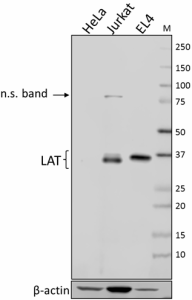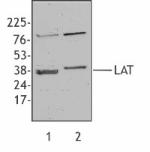- Clone
- 11B.12 (See other available formats)
- Regulatory Status
- RUO
- Other Names
- Linker for activation of T-cells family member 1, pp36, p36-38
- Isotype
- Mouse IgG1, κ
- Ave. Rating
- Submit a Review
- Product Citations
- publications

-

Total cell lysates (15 µg total protein) from HeLa (negative control), Jurkat, and EL4 cells were resolved by 4-20% Tris-Gel electrophoresis, transferred to a nitrocellulose membrane, and probed with 1.0 µg/mL (1:500 dilution) of Purified anti-LAT Antibody, clone 11B.12, overnight at 4°C. Proteins were visualized by chemiluminescence detection using HRP goat anti-mouse IgG Antibody (Cat. No. 405306) at a 1:3000 dilution. Direct-Blot™ HRP anti-β-Actin Antibody (Cat. No. 664804) was used as a loading control at a 1:5000 dilution (lower). -

Western blot analysis of extracts from Jurkat cells (lane 1) and mouse thymocytes (lane 2) using anti-LAT, clone 11B.12.
LAT is a transmembrane molecule that mediates signaling following the engagement of a number of cell surface receptors including TCR during mature T cell activation, pre-TCR during T cell development, Fc RIII on NK cells, and FcεRI on mast cells.LAT is multiply phosphorylated on tyrosines by ZAP-70 and Syk, which leads to downstream effects that include release of intracellular calcium, PKC activation, MAPK activation and cytoskeletal reorganization.Palmitoylation of LAT is required for its localization to lipid rafts and efficient phosphorylation.
Product DetailsProduct Details
- Verified Reactivity
- Mouse, Human
- Antibody Type
- Monoclonal
- Host Species
- Mouse
- Immunogen
- GST fusion protein corresponding to residues 31-233 of human LAT, cytoplasmic domain.
- Formulation
- This antibody is provided in phosphate-buffered solution, pH 7.2, containing 0.09% sodium azide. Final antibody concentration is 0.5 mg/ml.
- Preparation
- The antibody was purified by affinity chromatography.
- Concentration
- 0.5 mg/ml
- Storage & Handling
- Upon receipt, store between 2°C and 8°C
- Application
-
WB - Quality tested
- Recommended Usage
-
Each lot of this antibody is quality control tested by Western blotting. For Western blotting, the suggested use of this reagent is 0.2 - 1.0 µg per ml. It is recommended that the reagent be titrated for optimal performance for each application.
- Application Notes
-
This clone may recognize a ~80 kD protein of unknown origin in some cell lines and tissue homogenates. It is also predicted to recognize rat LAT due to complete sequence homology between human, mouse, and rat LAT.
-
Application References
(PubMed link indicates BioLegend citation) -
- Dorn T, et al. 2007. Blood 109:2346.
- Sloan D, et al. 2006. J. Immunol. 176:1825
- Product Citations
-
- RRID
-
AB_2157732 (BioLegend Cat. No. 641102)
Antigen Details
- Structure
- Type III transmembrane protein, MW of 28 kD but expected at 36-38 kD due to post-translational modifications including palmitoylation; multiple isoforms with a predicted MW of 25-28 kD reported.
- Distribution
-
Expressed in thymus, T-cells, NK cells, mast cells and, at lower levels, in spleen. Present in T-cells but not B-cells (at protein level).
- Function
- LAT is required for signaling through a number of cell surface receptors including TCR, FcγRIII, and FcεRI.
- Interaction
- Interacts directly with GRB2, GRAP, GRAP2, PLCG1 and PLCG2. Interacts indirectly with CBL, SOS, VAV, LCP2, SHB, SKAP2, MIST,and FcγR1A
- Cell Type
- Mast cells, NK cells, T cells
- Biology Area
- Cell Biology, Immunology, Signal Transduction
- Molecular Family
- Phospho-Proteins
- Antigen References
-
1. Zhang W et al. 1998. Cell 92:83.
2. Weber JR. et al. 1998. J. Exp. Med. 187:1157 - Regulation
- Phosphorylated on tyrosines by ZAP-70 upon TCR activation, or by SYK upon other immunoreceptor activation
- Gene ID
- 27040 View all products for this Gene ID
- UniProt
- View information about LAT on UniProt.org
Related FAQs
Other Formats
View All LAT Reagents Request Custom Conjugation| Description | Clone | Applications |
|---|---|---|
| Purified anti-LAT | 11B.12 | WB |
Compare Data Across All Formats
This data display is provided for general comparisons between formats.
Your actual data may vary due to variations in samples, target cells, instruments and their settings, staining conditions, and other factors.
If you need assistance with selecting the best format contact our expert technical support team.









Follow Us